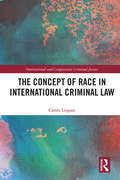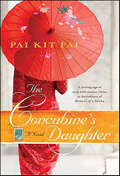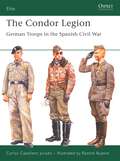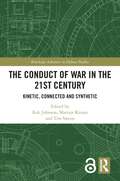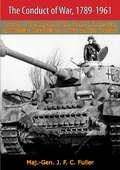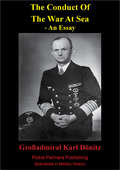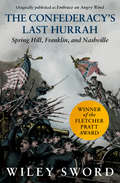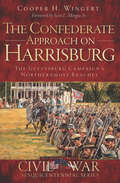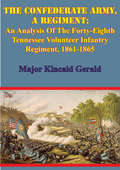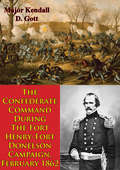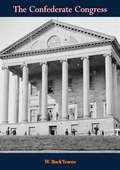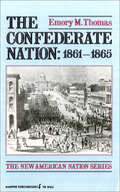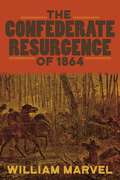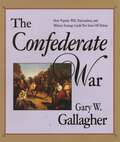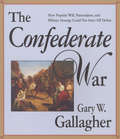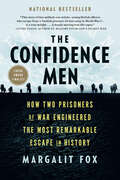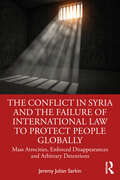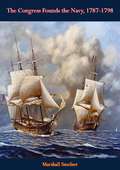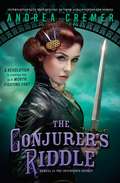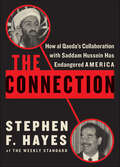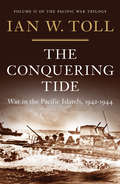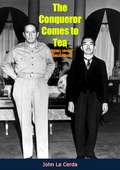- Table View
- List View
The Concept of Race in International Criminal Law (International and Comparative Criminal Justice)
by Carola LingaasMembers of racial groups are protected under international law against genocide, persecution, and apartheid. But what is race – and why was this contentious term not discussed when drafting the Statute of the International Criminal Court? Although the law uses this term, is it legitimate to talk about race today, let alone convict anyone for committing a crime against a racial group? This book is the first comprehensive study of the concept of race in international criminal law. It explores the theoretical underpinnings for the crimes of genocide, apartheid, and persecution, and analyses all the relevant legal instruments, case law, and scholarship. It exposes how the international criminal tribunals have largely circumvented the topic of race, and how incoherent jurisprudence has resulted in inconsistent protection. The book provides important new interpretations of a problematic concept by subjecting it to a multifaceted and interdisciplinary analysis. The study argues that race in international criminal law should be constructed according to the perpetrator's perception of the victims’ ostensible racial otherness. The perpetrator’s imagination as manifested through his behaviour defines the victims’ racial group membership. It will be of interest to students and practitioners of international criminal law, as well as those studying genocide, apartheid, and race in domestic and international law.
The Concubine's Daughter: A Novel
by Pai Kit FaiAn epic, heart-wrenching story of a mother and daughter's journey to their destiny.Lotus Feet. He would give his daughter the dainty feet of a courtesan. This would enhance her beauty and her price, making her future shine like a new coin. He smiled to himself, pouring fresh tea. And it would stop her from running away…When the young concubine of an old farmer in rural China gives birth to a daughter called Li-Xia, or "Beautiful One," the child seems destined to become a concubine herself. Li refuses to submit to her fate, outwitting her father's orders to bind her feet and escaping the silk farm with an English sea captain. Li takes her first steps toward fulfilling her mother's dreams of becoming a scholar—but her final triumph must be left to her daughter, Su Sing, "Little Star," in a journey that will take her from remote mountain refuges to the perils of Hong Kong on the eve of World War II.
The Condor Legion
by Ramiro Bujeiro Carlos JuradoOsprey's examination of German forces prior to World War II (1939-1945). The Condor Legion was the expeditionary force of soldiers and airmen sent by Hitler to aid Franco's Nationalists in the Spanish Civil War (1936-1939). The Germans used the war as an opportunity to develop equipment and tactics, and their force included not only instructors, but also combat units of artillery, tanks and aircraft. These units tested guns, tanks and planes and perfected techniques which were used in the 1940 Blitzkrieg. Many of the officers prominent in the early campaigns of World War II won their first successes in Spain. This book details the Legion and its unique uniform and insignia.
The Conduct of Hostilities under the Law of International Armed Conflict
by Yoram DinsteinWritten by the leading commentator on the subject, this is the seminal textbook on the law of international armed conflict. Focusing on recent issues arising in the course of hostilities between States, it explores the dividing line between lawful and unlawful combatants, the meaning of war crimes and command responsibility, the range of prohibited weapons, the distinction between combatants and civilians, the parameters of targeting and proportionality, the loss of protection from attack (including 'direct participation in hostilities') and special protection (granted, pre-eminently, to the environment and to cultural property). In a completely revised and updated text, the author expertly covers the key principles and includes important new issues, including the use of autonomous weapons and the complexities of urban warfare. The subtleties and nuances of the international law of armed conflict are made accessible to the student and practitioner alike, whilst retaining the academic rigour of previous editions.
The Conduct of War in the 21st Century: Kinetic, Connected and Synthetic (Routledge Advances in Defence Studies)
by Rob Johnson, Martijn Kitzen and Tim SweijsThis book examines the key dimensions of 21st century war, and shows that orthodox thinking about war, particularly what it is and how it is fought, needs to be updated. Accelerating societal, economic, political and technological change affects how we prepare, equip and organise for war, as well as how we conduct war – both in its low-tech and high-tech forms, and whether it is with high intensity or low intensity. The volume examines changes in warfare by investigating the key features of the conduct of war during the first decades of the 21st century. Conceptually centred around the terms ‘kinetic’, ‘connected’ and ‘synthetic’, the analysis delves into a wide range of topics. The contributions discuss hybrid warfare, cyber and influence activities, machine learning and artificial intelligence, the use of armed drones and air power, the implications of the counterinsurgency experiences in Iraq, Afghanistan and Syria, as well as the consequences for law(fare) and decision making. This work will be of much interest to students of military and strategic studies, security studies and International Relations.
The Conduct of War, 1789-1961: A Study of the Impact of the French, Industrial, and Russian Revolutions on War and its Conduct
by Maj.-Gen J. F. C. Fuller“A tour de force in the way it embraces and weaves together the political, economic and military factors”—B. H. Liddell Hart“A work which sums up succinctly the learning of a life-time.”—New StatesmanThe Conduct of War, 1789-1961, which was originally published in 1961, is a study of the way in which political and economic changes since the French Revolution have altered both the techniques and the aims of war.The author begins by studying the limited wars that were possible in the age of absolute rulers, and the destructive impact of revolutionary and democratic government on this state of affairs. Not only did the new armies of the Napoleonic age grow immensely in size and military power: the aims for which the war was fought began to change.Now it is no longer a question of forcing the enemy government to change its policy in specific ways: the purpose is the destruction of that government and the absolute surrender of its people.Such a concept of war, the author contends, is a disastrous return to barbarism, and in this book he considers his study in the light of post-war events with Communist countries.
The Conduct of the War Of Sea - An Essay
by Großadmiral Karl DönitzAdmiral Dönitz' essay on the Conduct of the War at Sea is published... for several reasons. It has historical significance as a review of the German Navy's participation in World War II. Also, from the standpoint of naval science, the opinions of an enemy naval officer of Dönitz' caliber merit study and consideration. Still more important is the forceful presentation of Hitler's fatal error in disregarding or underestimating the necessity of sea power as a prerequisite to a major political power engaging successfully in war of any magnitude - or, by the same token, defending successfully its own political and economic boundaries and rights.In order to assist in the analysis of the essay, this publication includes a biographical sketch of the author, introductory remarks concerning the essay's background and contents and a list of subjects in the form of a table of contents Doenitz was interrogated in order to amplify certain portions and theories of the essay, and his interrogation is also published herewith . His reaction to such interrogation and to analyses made of the essay is set forth in the Introduction.
The Confederacy's Last Hurrah: Spring Hill, Franklin, and Nashville (Modern War Studies)
by Wiley SwordThe rise of Civil War general John Bell Hood, his command of the Confederate Army of Tennessee, and the decisions that led to its downfall. Though he barely escaped expulsion from West Point, John Bell Hood quickly rose through the ranks of the Confederate army. With bold leadership in the battles of Gaines&’ Mill and Antietam, Hood won favor with Confederate president Jefferson Davis. But his fortunes in war took a tragic turn when he assumed command of the Confederate Army of Tennessee. After the fall of Atlanta, Hood marched his troops north in an attempt to draw Union army general William T. Sherman from his devastating &“March to the Sea.&” But the ploy proved ruinous for the South. While Sherman was undeterred from his scorched-earth campaign, Hood and his troops charged headlong into catastrophe. In this compelling account, Wiley Sword illustrates the poor command decisions and reckless pride that made a disaster of the Army of Tennessee&’s final campaign. From Spring Hill, where they squandered an early advantage, Hood and his troops launched an ill-fated attack on the neighboring town of Franklin. The disastrous battle came to be known as the &“Gettysburg of the West.&” But worse was to come as Hood pressed on to Nashville, where his battered troops suffered the worst defeat of the entire war. Winner of the Fletcher Pratt Award for best work of nonfiction about the Civil War, The Confederacy&’s Last Hurrah chronicles the destruction of the South&’s second largest army. &“Narrated with brisk attention to the nuances of strategy—and with measured solemnity over the waste of life in war,&” it is a groundbreaking work of scholarship told with authority and compassion (Kirkus Reviews).
The Confederate Approach on Harrisburg: The Gettysburg Campaign's Northernmost Reaches (Sesquicentennial Series)
by Cooper H. WingertThe little-known story of how Southern forces came close to invading the capital of Pennsylvania—includes photos. In June 1863, Harrisburg braced for an invasion. The Confederate troops of Lt. Gen. Richard S. Ewell steadily moved toward the Pennsylvania capital. Capturing Carlisle en route, Ewell sent forth a brigade of cavalry under Brigadier Gen. Albert Gallatin Jenkins. After occupying Mechanicsburg for two days, Jenkins&’s troops skirmished with Union militia near Harrisburg. Jenkins then reported back to Ewell that Harrisburg was vulnerable. Ewell, however, received orders from army commander Robert E. Lee to concentrate southward—toward Gettysburg—immediately. Left in front of Harrisburg, Jenkins had to fight his way out at the Battle of Sporting Hill. The following day, Jeb Stuart&’s Confederate cavalry made its way to Carlisle and began the infamous shelling of its Union defenders and civilian population. Running out of ammunition and finally making contact with Lee, Stuart also retired south toward Gettysburg. In this enlightening history, author Cooper H. Wingert traces the Confederates to the gates of Harrisburg in these northernmost actions of the Gettysburg Campaign.
The Confederate Army, A Regiment: An Analysis Of The Forty-Eighth Tennessee Volunteer Infantry Regiment, 1861-1865
by Major Kincaid GeraldThe performance of an army is often evaluated by its achievements as a whole, or by that of its commanders or perhaps even its divisions. Often lost in the equation is the small unit. After the great plans are complete and the logistics preparations are accomplished, it is the collective performance of the small unit that ultimately decides the battle.This thesis analyses the campaigns, soldiers, organization, equipment, and performance of just one regiment: the 48th Tennessee Volunteer Infantry. Material concerning the 48th includes numerous primary sources: the Official Records, Confederate Veteran, The Southern Historical Papers, Southern Bivouac, local histories, and the CARL microfiche library of unit histories (Note: the 48th is not included in these unit histories). Other primary references include war diaries of two officers, three enlisted men, and copies of the 48th's Quartermaster records.This thesis concludes that, while training and equipment of the 48th was sometimes poor, it was effective in numerous engagements, despite its relative small size. The ultimate demise of the unit was due to personnel losses.
The Confederate Battle Flag: America's Most Embattled Emblem
by John M. CoskiIn recent years, the Confederate flag has become as much a news item as a Civil War relic. Intense public debates have erupted over Confederate flags flying atop state capitols, being incorporated into state flags, waving from dormitory windows, or adorning the T-shirts and jeans of public school children. To some, this piece of cloth is a symbol of white supremacy and enduring racial injustice; to others, it represents a rich Southern heritage and an essential link to a glorious past. Polarizing Americans, these "flag wars" reveal the profound--and still unhealed--schisms that have plagued the country since the Civil War. The Confederate Battle Flag is the first comprehensive history of this contested symbol. Transcending conventional partisanship, John Coski reveals the flag's origins as one of many banners unfurled on the battlefields of the Civil War. He shows how it emerged as the preeminent representation of the Confederacy and was transformed into a cultural icon from Reconstruction on, becoming an aggressively racist symbol only after World War II and during the Civil Rights movement. We gain unique insight into the fine line between the flag's use as a historical emblem and as an invocation of the Confederate nation and all it stood for. Pursuing the flag's conflicting meanings, Coski suggests how this provocative artifact, which has been viewed with pride, fear, anger, nostalgia, and disgust, might ultimately provide Americans with the common ground of a shared and complex history.
The Confederate Command During The Fort Henry-Fort Donelson Campaign, February 1862
by Major Kendall D. GottThis study investigates the decisive factors that affected the Fort Henry-Fort Donelson campaign in February 1862. The thesis is relevant not only to the study of history, but as a series of lessons for all commanders.In the final analysis, the ultimate failure of the Confederates during this campaign can be attributed directly to the actions of General Albert Sidney Johnston. He failed to develop an adequate strategy to meet the expected invasion from the North or to insure that each subordinate command in his department was prepared for the onslaught. Johnston also failed to establish a command structure to support his Department. Most damaging of all, Johnston neglected the defenses of the Tennessee and Cumberland rivers, which served as invasion routes through the center of his departmentIronically, one of the worst generals of the Confederacy correctly saw Fort Donelson as the key to stopping Grant and protecting Nashville. Had he been better supported by his superiors and by the officers serving at the fort with him, the Confederates may have won a victory at Fort Donelson and secured the Western Department for several months.
The Confederate Congress
by W. Buck YearnsPublished in 1960, this study of the Confederate Congress and its relation to the Jefferson Davis administration describes the legislation, debates, personalities, and politics of this turbulent time. Initially, the Confederate Congress and President Davis were in agreement on how to win the war and lawmaking proceeded in a routine manner. However, as the war progressed conflicts arose as Congress and the President were faced with the difficulties of providing a poor nation with the facilities to combat a richer one. Much of the later legislation was written only after bitter political controversy. An appendix gives brief biographical data on the Confederate congressmen, including their voting records.-Print ed.
The Confederate Fiddle
by Jeanne WilliamsA Civil War Story of High Adventure In 1863 Brownsville, Texas, was the only port open to the South. Vin Clayburn joins a wagon train in Missouri taking cotton, the Confederacy's money crop, to the Brownsville port for export to France, England, and Germany. This deeply moving and adventurous book is a story of loyalty— the devotion of Vin Clayburn to home and belief—even to the sacrifice of a prized family violin. Vin longs to be like his dashing older brother in the Confederate Army instead of a driver in a cotton train traveling from Missouri to Brownsville. Though he is determined to see it through, he resents the routine job of carrying supplies and missing "a hero's glory." He learns, however, that his unglamorous task involves thrills, courage and daring and—even more difficult—understanding and respect for those whose views are different from his own. Most of all, in a compelling climax, Vin comes to realize that there are many different kinds of heroes.
The Confederate Nation: 1861 To 1865 (The New American Nation Series)
by Emory M. Thomas“Incisive and insightful. . . . As good a short history of the Southern war effort as we have.” —T. Harry Williams, Pulitzer Prize–winning author of Lincoln and His GeneralsEmory M. Thomas’s critically acclaimed chronicle of the Confederacy remains widely recognized as the standard history of the South during the Civil War. Now with a new introduction by the author, The Confederate Nation presents a highly readable, highly personal portrait of the Southern experience during these years. Thomas, renowned for his illuminating biographies of Robert E. Lee and other Southern generals, here delivers the definitive account of the political and military events that shook the nation during its period of greatest turmoil.“The Confederate Nation has yet to be superseded as the standard title on the subject.” —Journal of Southern History“A serious, scholarly, readable work.” —C. Vann Woodward, The New Republic“One of America’s most eminent Civil War historians.” —Richmond Times-Dispatch
The Confederate Resurgence of 1864 (Conflicting Worlds: New Dimensions of the American Civil War)
by William MarvelWilliam Marvel’s The Confederate Resurgence of 1864 examines a dozen understudied Confederate and Union military operations carried out during the winter and spring of 1864 that, taken cumulatively, greatly revived white southerners’ hopes for independence. Among the pivotal moments during this period were the sinking of the USS Housatonic by the CSS Hunley; Nathan Bedford Forrest’s defeat of William Sooy Smith’s cavalry raid; and the Confederate army’s victory at Olustee, Florida. The repulse of Union advances on Dalton, Georgia; botched Union raids on Richmond; and the capture of the Union garrison in Plymouth, North Carolina, likewise suggested that the tide of fighting had turned toward the Confederate cause. These events boosted the morale of southern troops and citizens, and caused grave concerns about the war effort in the North and in the mind of Abraham Lincoln.In late 1863 and early 1864, dejection and despair prevailed in the South: Union soldiers had vanquished Robert E. Lee at Gettysburg, the Confederate nation had been cut in two, Tennessee was lost, and Braxton Bragg’s army had been utterly routed at Chattanooga. Defeatism loomed in the South during the first weeks of 1864, and the ease with which William T. Sherman rampaged across Mississippi illustrated the dominance of Union forces, while Confederates’ ineffectual assault on New Bern accentuated their weakness. Yet between February 20 and April 30, southern troops enjoyed an unbroken string of successes that included turning back a concerted Union offensive during the Red River campaign as well as Forrest’s incursions into Union City, Paducah, and Fort Pillow. Aided by flawed strategy implemented by Union army officers, the achievements of Confederate forces restored hope and confidence in camp and on the southern home front. The Confederacy’s battlefield successes during the early months of 1864 remained almost unnoticed by Civil War scholars until recently and have never been studied collectively for their impact on Confederate morale. The victories invigorated southern combatants, demonstrating how abruptly the most dismal military prospects could be reversed. Without that experience, Marvel argues, the Confederates who faced Sherman and Grant in the spring of that year would certainly have displayed less ferocity and likely would have succumbed more quickly to the demoralization that ultimately led to the collapse of Confederate resistance.
The Confederate War
by Gary GallagherThis book argues that we should not ask why the Confederacy collapsed so soon, but rather how it lasted so long. The book re-examines the Confederate experience through the actions and words of the people who lived it, to show how the home front responded to the war, endured great hardships and assembled armies that fought with spirit and determination.
The Confederate War (American Civil War Classics Ser.)
by Gary W. GallagherIf one is to believe contemporary historians, the South never had a chance. Many allege that the Confederacy lost the Civil War because of internal division or civilian disaffection; others point to flawed military strategy or ambivalence over slavery. But, argues distinguished historian Gary Gallagher, we should not ask why the Confederacy collapsed so soon but rather how it lasted so long. In The Confederate War he reexamines the Confederate experience through the actions and words of the people who lived it to show how the home front responded to the war, endured great hardships, and assembled armies that fought with tremendous spirit and determination. Gallagher’s portrait highlights a powerful sense of Confederate patriotism and unity in the face of a determined adversary. Drawing on letters, diaries, and newspapers of the day, he shows that Southerners held not only an unflagging belief in their way of life, which sustained them to the bitter end, but also a widespread expectation of victory and a strong popular will closely attuned to military events. In fact, the army’s “offensive-defensive” strategy came remarkably close to triumph, claims Gallagher—in contrast to the many historians who believe that a more purely defensive strategy or a guerrilla resistance could have won the war for the South. To understand why the South lost, Gallagher says we need look no further than the war itself: after a long struggle that brought enormous loss of life and property, Southerners finally realized that they had been beaten on the battlefield. Gallagher’s interpretation of the Confederates and their cause boldly challenges current historical thinking and invites readers to reconsider their own conceptions of the American Civil War.
The Confidence Men: How Two Prisoners of War Engineered the Most Remarkable Escape in History
by Margalit FoxThe astonishing true story of two World War I prisoners who pulled off one of the most ingenious escapes of all time.&“A wonder, a marvel, a feat of invention and dogged persistence, and most of all, a testament to the power of the human capacity to believe.&”—Liza Mundy, author of Code Girls: The Untold Story of the American Women Code Breakers of World War II Imprisoned in a remote Turkish POW camp during World War I, having survived a two-month forced march and a terrifying shootout in the desert, two British officers, Harry Jones and Cedric Hill, join forces to bamboozle their iron-fisted captors. To stave off despair and boredom, Jones takes a handmade Ouija board and fakes elaborate séances for his fellow prisoners. Word gets around, and one day an Ottoman official approaches Jones with a query: Could Jones contact the spirit world to find a vast treasure rumored to be buried nearby? Jones, a trained lawyer, and Hill, a brilliant magician, use the Ouija board—and their keen understanding of the psychology of deception—to build a trap for their captors that will ultimately lead them to freedom. A gripping nonfiction thriller, The Confidence Men is the story of one of the only known con games played for a good cause—and of a profound but unlikely friendship. Had it not been for &“the Great War,&” Jones, the Oxford-educated son of a British lord, and Hill, a mechanic on an Australian sheep ranch, would never have met. But in pain, loneliness, hunger, and isolation, they formed a powerful emotional and intellectual alliance that saved both of their lives. Margalit Fox brings her &“nose for interesting facts, the ability to construct a taut narrative arc, and a Dickens-level gift for concisely conveying personality&” (Kathryn Schulz, New York) to this tale of psychological strategy that is rife with cunning, danger, and moments of high farce that rival anything in Catch-22.
The Conflict in Syria and the Failure of International Law to Protect People Globally: Mass Atrocities, Enforced Disappearances and Arbitrary Detentions
by Jeremy Julian SarkinThis book explores, through the lens of the conflict in Syria, why international law and the United Nations have failed to halt conflict and massive human rights violations in many places around the world which has allowed tens of millions of people to be killed and hundreds of millions more to be harmed. The work presents a critical socio-legal analysis of the failures of international law and the United Nations (UN) to deal with mass atrocities and conflict. It argues that international law, in the way it is set up and operates, falls short in dealing with these issues in many respects. The argument is that international law is state-centred rather than victim-friendly, is, to some extent, outdated, is vague and often difficult to understand and, therefore, at times, hard to apply. While various accountability processes have come to the fore recently, processes do not exist to assist individual victims while the conflict occurs or the abuses are being perpetrated. The book focuses on the problems of international law and the UN and, in the context of the many enforced disappearances and arbitrary detentions in Syria, why nothing has been done to deal with a rogue state that has regularly violated international law. It examines why the responsibility to protect (R2P) has not been applied and why it ought to be used, generally, and in Syria. It uses the Syrian context to evaluate the weaknesses of the system and why reform is needed. It examines the UN institutional mechanisms, the role they play and why a civilian protection system is needed. It examines what mechanism ought to be set up to deal with the possible one million people who have been disappeared and detained in Syria. The book will be a valuable resource for students, academics and policy-makers working in the areas of public international law, international human rights law, political science and peace and security studies.
The Congress Founds the Navy, 1787-1798: 1798
by Marshall SmelserIn this book Professor Smelser seeks to fill the void in the American Naval History—the politics behind the U.S. Navy.“Naval historians have usually given little attention to the political shaping of national naval policy, and political historians (a more numerous species) have generally presented only the final decisions of naval policy without much investigation of the policy-making process.”
The Conjurer's Riddle
by Andrea CremerThe Revolution is beginning–and Charlotte may be on the wrong side. In this sequel to The Inventor's Secret, Charlotte and her companions escape the British Empire, but they haven't left danger behind. In fact, if they go against the revolutionaries, they face even greater peril. Charlotte leads her group of exiles west, plunging into a wild world of shady merchants and surly rivermen on the way to New Orleans. But as Charlotte learns more about the revolution she has championed, she wonders if she's on the right side after all. Charlotte and her friends get to know the mystical New Orleans bayou and deep into the shadowy tunnels below the city–the den of criminals, assassins and pirates–Charlotte must decide if the revolution's goals justify their means, or if some things, like the lives of her friends, are too sacred to sacrifice. This alternate-history adventure series asks the questions: What would have happened if America had lost the Revolutionary War? And what would people be willing to do to finally taste freedom? Praise for The Conjurer's Riddle:"This is classic steampunk [with] exotic and picturesque locales, lots of interesting machinery, and the adrenaline rush of following the adventures of an honest and fearless heroine. A suitably swashbuckling sequel."--Kirkus Reviews"This invigorating series neatly fits into the sagacategory, with loads of adventure, lots of explosions, plenty of pirates, and still some pages left forromance. The dramatic ending sweeps readers right toward the next book."--Booklist "Fans will enjoy seeing Charlotte take on a more serious role as she faces multiple factions while forging her own path."--VOYAPraise for The Inventor's Secret:* "Cremer...creates an inventive blend of steampunk and alternative history in this new series. She gives readers a fantastical world with mechanical wonders and an opulent vintage setting. The characters are interesting and well developed. Readers will be drawn to future installments."--VOYA, starred review"[A]n entertaining romp in a richly imaginative setting."--Kirkus ReviewsFrom the Hardcover edition.
The Connection: How al Qaeda's Collaboration with Saddam Hussein Has Endangered America
by Stephen F. HayesIn the wake of 9/11 no one knew when the next attack would come, or where it would come from. America's enemies seemed gathered on all sides, and for several nerve-racking months, we lived in fear that the perpetrators might be plotting another action or, worse, that our most dangerous enemies -- al Qaeda and Saddam Hussein's murderous regime in Iraq -- could be banding together against us.The Bush administration and CIA director George Tenet warned against complacency and pointed to growing indications that al Qaeda and Iraq were in league. But their case was undercut by unnamed intelligence officials, skeptical politicians, and a compliant media. So America relaxed. A comforting consensus settled in: Osama bin Laden was an impassioned fundamentalist, Saddam a secular autocrat. The two would never, could never, work together. ABC News reported that there was no connection between them, and the New York Times said so too, and pretty soon just about everyone agreed.Just about everyone was wrong.In The Connection, Stephen Hayes draws on CIA debriefings, top-secret memos from our national intelligence agencies, and interviews with Iraqi military leaders and Washington insiders to demonstrate that Saddam and bin Laden not only could work together, they did -- a curious relationship that stretches back more than a decade and may include collaboration on terrorist acts, chemical-weapons training, and sheltering some of the world's most wanted radicals.Stephen Hayes's bombshell Weekly Standard piece on this topic was cited by Vice President Cheney as the "best source of information" about the Saddam-al Qaeda connections. Now Hayes delves even deeper, exposing the inner workings of America's deadliest opponents and providing a clear-eyed corrective to reams of underreported, politicized, and just plain wrong information.The Connection is both a gripping snapshot of the War on Terror and a case study in how bureaucratic assumptions and media arrogance can put us all at risk.
The Conquering Tide: War in the Pacific Islands, 1942–1944
by Ian W. TollNew York Times Bestseller The devastation of Pearl Harbor and the American victory at Midway were prelude to a greater challenge: rolling back the vast Japanese Pacific empire, island by island. This masterful history encompasses the heart of the Pacific War—the period between mid-1942 and mid-1944—when parallel Allied counteroffensives north and south of the equator washed over Japan's far-flung island empire like a "conquering tide," concluding with Japan's irreversible strategic defeat in the Marianas. It was the largest, bloodiest, most costly, most technically innovative and logistically complicated amphibious war in history, and it fostered bitter interservice rivalries, leaving wounds that even victory could not heal. Often overlooked, these are the years and fights that decided the Pacific War. Ian W. Toll's battle scenes—in the air, at sea, and in the jungles—are simply riveting. He also takes the reader into the wartime councils in Washington and Tokyo where politics and strategy often collided, and into the struggle to mobilize wartime production, which was the secret of Allied victory. Brilliantly researched, the narrative is propelled and colored by firsthand accounts—letters, diaries, debriefings, and memoirs—that are the raw material of the telling details, shrewd judgment, and penetrating insight of this magisterial history. This volume—continuing the "marvelously readable dramatic narrative" (San Francisco Chronicle) of Pacific Crucible—marks the second installment of the Pacific War Trilogy, which will stand as the first history of the entire Pacific War to be published in at least twenty-five years.
The Conqueror Comes to Tea: Japan under MacArthur
by John La CerdaThe story of Japan is no longer—if it was ever—the delicate words and prints of the travel literature of the nineteenth and early twentieth centuries. A scheme for ruling the world has been followed by a costly war; the war by unconditional surrender; the surrender by occupation. From these tumbling events is emerging the new story, with characters and plots aplenty in the stark, sometimes terrifying and always swiftly moving drama of Japan today. It has all the makings of a novel…
